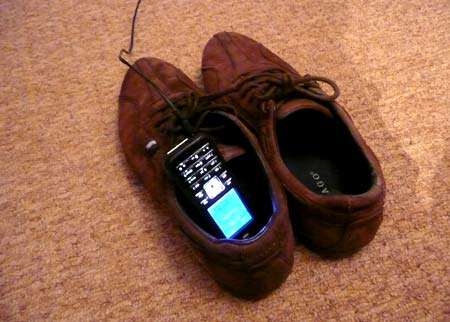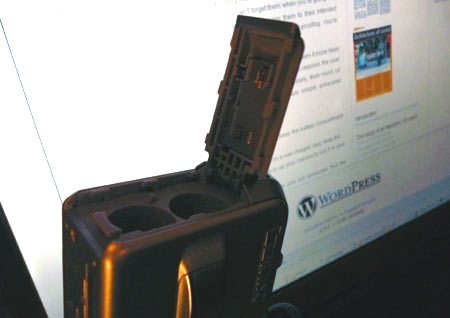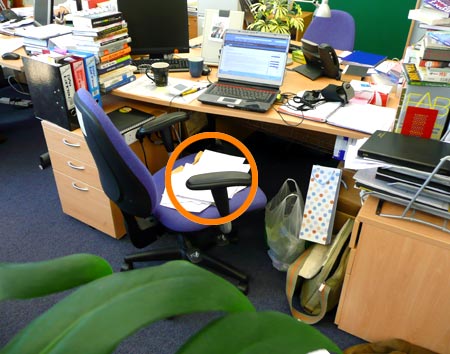
Update: Also known as Useful Landmines in the 43 Folders world – thanks Pantufla!
Mistake-proofing – poka-yoke – can be as simple as encouraging/forcing yourself to do things in a sequence, to avoid forgetting or avoiding intermediate steps. If you’re the sort of person who hangs a jacket or bag on the door handle, so it can’t be forgotten on the way out, puts things in front of the door so you can’t forget them when you’re going out, or at the top or bottom of the stairs so you’ll remember to carry them to their intended destination next time you’re using the stairs, you’re engaged in mistake-proofing. You’re introducing a behaviour-shaping constraint to assist your own effectiveness.
In the above photo, putting the mobile phone (on-charge) inside a shoe makes it more likely that it will be remembered when going out: the act of putting the shoes on requires the user to pick up the phone, which could otherwise be easily forgotten. Similarly, Mark Hurst (of Good Experience and ‘Broken’ fame) regularly features two very simple poka-yoke procedures in his Uncle Mark’s Gift Guide & Almanac:
How to remember if the batteries aren’t in your camera
Summary: If the batteries are dead, or aren’t in the camera, keep the battery compartment open.
Description: When you’re charging your camera batteries (in a wall charger, say), keep the camera’s battery compartment open. That way, if you pick up your camera to put it in your pocket or purse, you’ll see that the battery compartment is open and will remember that the batteries aren’t in it.

There’s also this:
How to make sure they see the papers you dropped off
Summary: Put the papers on their chair.
Description: Here’s a tip I learned years ago and have used ever since. If you want to make sure that someone sees the papers you dropped off at their desk, put the papers on their chair. The natural inclination is to drop the files on the keyboard, or beside the mousepad. What’s the first thing the person does when they get back to their desk? They shove the papers aside, onto a nearby pile. They want to check their e-mail immediately, and those papers are in the way!
But put the papers on their chair, and watch what happens: the person refuses to sit on them! They take a second to pick them up, and while they’re in-hand, the person takes a look at the files while they get comfortable in the chair. Bingo: you guarantee attention to your drop-off.

Of course the papers-on-chair method can also be used to remind (or discipline) yourself about dealing with important papers.
This kind of very simple sequencing poka-yoke comes almost naturally in our everyday lives, at least with certain tasks. Sometimes it’s simply reminding ourselves to do something (e.g. putting a Post-It note somewhere we can see it); other times it’s trying to prevent us proceeding until some action has been taken (e.g. putting a Post-It note right in the middle of the computer screen so we can’t ignore it). Donald Norman’s Things That Make Us Smart has some interesting discussion of the power of Post-It notes and their importance as “information in the world”, disburdening some of our mental load – also part of the whole Getting Things Done phenomenon.
Sometimes we even (consciously or otherwise) try to ‘trick’ ourselves into behaving how we want to (or know we should) – the random offset alarm clock (patent; Halfbakery discussion) and Gauri Nanda’s “runaway success” Clocky being examples that spring to mind. (I once had a bedside clock radio where the button to set the minutes no longer worked, which meant that I could only set it either on-the-hour, or, because I forgot to do it at the right moment, set it maybe between 5 and 30 minutes fast. That meant that there was an uncertainty built into every time I glanced at the display, and indeed every time the alarm went off. I was rarely late, as a result.)
I have a hunch that almost trivially simple sequencing poka-yokes (in particular) could be important in designing for sustainable behaviour, such as reducing energy use and waste generation. For example, if your rubbish bin had a recycling box built into the top, so that you had to lift it out of the way (hinged, perhaps, to make it hassle to remove entirely) before putting anything into the main bin, it would be difficult to ignore the recycling box. Hence, learning as much as possible about different methods people use to mistake-proof themselves, or shape their own everyday behaviour, is likely to be useful in exapnding this line of research.
So, what are the everyday home-spun (or otherwise) tricks you use to help mistake-proof yourself?

Pingback: Magnetbox - links for 2008-02-13
Pingback: Poka Yoke « Going Back to Cyberspace
Pingback: How to enjoy taking notes and revising things
Pingback: Acuario 27 » Blog Archive » Poka Yoke II
Pingback: Design with Intent | Errorproofing Lens: The Patterns
Pingback: Détrompeurs : la suite